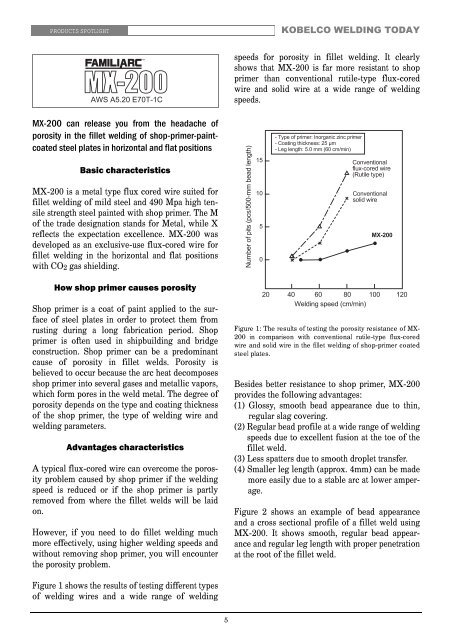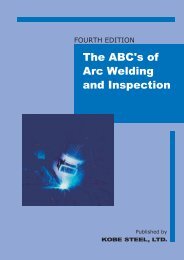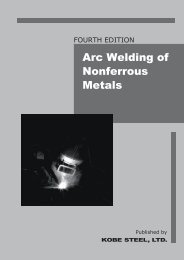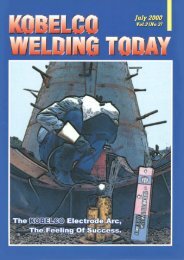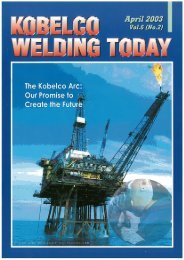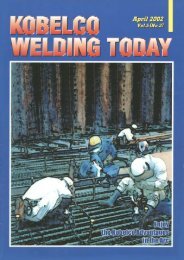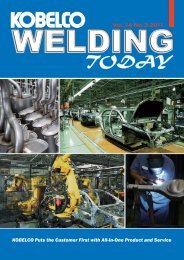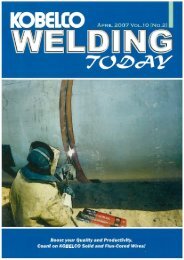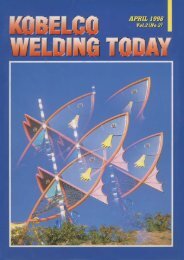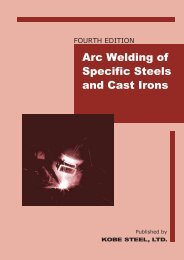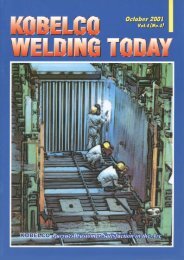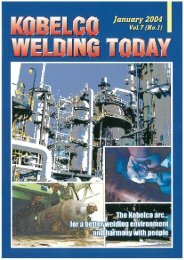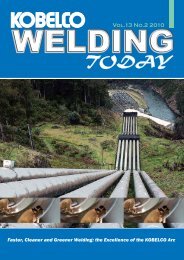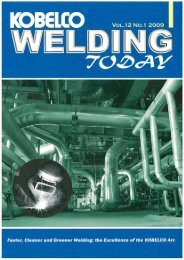KOBELCO WELDING CONSUMABLES
KOBELCO WELDING CONSUMABLES
KOBELCO WELDING CONSUMABLES
Create successful ePaper yourself
Turn your PDF publications into a flip-book with our unique Google optimized e-Paper software.
PRODUCTS SPOTLIGHT<br />
<strong>KOBELCO</strong> <strong>WELDING</strong> TODAY<br />
<br />
<br />
speeds for porosity in fillet welding. It clearly<br />
shows that MX-200 is far more resistant to shop<br />
primer than conventional rutile-type flux-cored<br />
wire and solid wire at a wide range of welding<br />
speeds.<br />
MX-200 can release you from the headache of<br />
porosity in the fillet welding of shop-primer-paintcoated<br />
steel plates in horizontal and flat positions<br />
Basic characteristics<br />
MX-200 is a metal type flux cored wire suited for<br />
fillet welding of mild steel and 490 Mpa high tensile<br />
strength steel painted with shop primer. The M<br />
of the trade designation stands for Metal, while X<br />
reflects the expectation excellence. MX-200 was<br />
developed as an exclusive-use flux-cored wire for<br />
fillet welding in the horizontal and flat positions<br />
with CO2 gas shielding.<br />
<br />
<br />
<br />
<br />
<br />
<br />
<br />
<br />
<br />
<br />
<br />
<br />
<br />
<br />
<br />
<br />
<br />
How shop primer causes porosity<br />
Shop primer is a coat of paint applied to the surface<br />
of steel plates in order to protect them from<br />
rusting during a long fabrication period. Shop<br />
primer is often used in shipbuilding and bridge<br />
construction. Shop primer can be a predominant<br />
cause of porosity in fillet welds. Porosity is<br />
believed to occur because the arc heat decomposes<br />
shop primer into several gases and metallic vapors,<br />
which form pores in the weld metal. The degree of<br />
porosity depends on the type and coating thickness<br />
of the shop primer, the type of welding wire and<br />
welding parameters.<br />
Advantages characteristics<br />
A typical flux-cored wire can overcome the porosity<br />
problem caused by shop primer if the welding<br />
speed is reduced or if the shop primer is partly<br />
removed from where the fillet welds will be laid<br />
on.<br />
However, if you need to do fillet welding much<br />
more effectively, using higher welding speeds and<br />
without removing shop primer, you will encounter<br />
the porosity problem.<br />
<br />
<br />
Figure 1: The results of testing the porosity resistance of MX-<br />
200 in comparison with conventional rutile-type flux-cored<br />
wire and solid wire in the fillet welding of shop-primer coated<br />
steel plates.<br />
Besides better resistance to shop primer, MX-200<br />
provides the following advantages:<br />
(1) Glossy, smooth bead appearance due to thin,<br />
regular slag covering.<br />
(2) Regular bead profile at a wide range of welding<br />
speeds due to excellent fusion at the toe of the<br />
fillet weld.<br />
(3) Less spatters due to smooth droplet transfer.<br />
(4) Smaller leg length (approx. 4mm) can be made<br />
more easily due to a stable arc at lower amperage.<br />
Figure 2 shows an example of bead appearance<br />
and a cross sectional profile of a fillet weld using<br />
MX-200. It shows smooth, regular bead appearance<br />
and regular leg length with proper penetration<br />
at the root of the fillet weld.<br />
Figure 1 shows the results of testing different types<br />
of welding wires and a wide range of welding<br />
5


